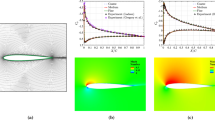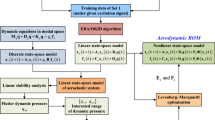Abstract
In this study, a reduced-order aerodynamic modeling framework by integration of a novel training data interpolation approach and the Eigensystem realization algorithm (ERA) is presented for fast prediction of transonic flutter boundary over a range of flight parameters. First, aerodynamic impulse responses are computed by using the technique of computational fluid dynamics (CFD) at grid points within parameter space, which are selected to cover the transonic regime of concern. Next, the training data interpolation approach by combining the discrete empirical interpolation method with the Kriging technique is used to generate the aerodynamic impulse response at arbitrary flight condition, without performing unsteady CFD simulations. Finally, the interpolated impulse response is used by ERA to extract the linear state-space aerodynamic model, which is coupled with the structural model for flutter characteristics analysis. To illustrate the proposed approach, a NACA 0012 airfoil of two degrees of freedom at zero mean angle of attack is investigated. The transonic flutter boundaries of the airfoil agree well with those obtained by using CFD-based technique.








Similar content being viewed by others
References
Lucia DJ, Beran PS, Silva WA (2004) Reduced-order modeling: new approaches for computational physics. Prog Aeronaut Sci 40(1–2):51–117
Hall KC, Thomas JP, Dowell EH (2000) Proper orthogonal decomposition technique for transonic unsteady aerodynamic flows. AIAA J 38(10):1853–1862
Chen G, Li Y, Yan G (2010) A nonlinear POD reduced order model for limit cycle oscillation prediction. Sci China Phys Mech Astron 53(7):1325–1332
Thomas JP, Dowell EH, Hall KC (2004) Modeling viscous transonic limit cycle oscillation behavior using a harmonic balance approach. J Aircr 41(6):1266–1274
Huang R, Hu HY, Zhao YH (2014) Nonlinear reduced-order modeling for multiple-input/multiple-output aerodynamic systems. AIAA J 52(6):1219–1231
Kim T, Hong M, Bhatia KG, Sengupta G (2005) Aeroelastic model reduction for affordable computational fluid dynamics-based flutter analysis. AIAA J 43(12):2487–2495
Kou J, Zhang W, Yin M (2016) Novel Wiener models with a time-delayed nonlinear block and their identification. Nonlinear Dyn 85(4):2389–2404
Zhang W, Wang B, Ye Z, Quan J (2012) Efficient method for limit cycle flutter analysis based on nonlinear aerodynamic reduced-order models. AIAA J 50(5):1019–1028
Huang R, Liu HJ, Yang ZJ, Zhao YH, Hu HY (2018) Nonlinear reduced-order models for transonic aeroelastic and aeroservoelastic problems. AIAA J 56(9):3718–3731
Liu HJ, Gao XM (2020) Identification of nonlinear aerodynamic systems with application to transonic aeroelasticity of aircraft structures. Nonlinear Dyn 100:1037–1056
Juang JN, Pappa RS (1985) An eigensystem realization algorithm for modal parameter identification and model reduction. J Guid Control Dyn 8(5):620–627
Silva WA (1985) Identification of nonlinear aeroelastic systems based on the Volterra theory: progress and opportunities. Nonlinear Dyn 39(1–2):25–62
Raveh DE (2004) Identification of computational-fluid dynamics based unsteady aerodynamic models for aeroelastic analysis. J Aircr 41(3):620–632
Cowan TJ, Arena AS, Gupta KK (2001) Accelerating computational fluid dynamics based aeroelastic predictions using system identification. J Aircr 38(1):81–87
Mannarino A, Mantegazza P (2015) Nonlinear aerodynamic reduced order modeling by discrete time recurrent neural networks. Aerosp Sci Technol 47:406–419
Mackman TJ, Allen CB, Ghoreyshi M, Badcock KJ (2013) Comparison of adaptive sampling methods for generation of surrogate aerodynamic models. AIAA J 51(4):797–808
Huang R, Li HK, Hu HY, Zhao YH (2015) Open/closed-loop aeroservoelastic predictions via nonlinear, reduced-order aerodynamic models. AIAA J 53(7):1812–1824
Rowley CW (2005) Model reduction for fluids, using balanced proper orthogonal decomposition. Int J Bifurc Chaos 15(03):997–1013
Ma Z, Ahuja S, Rowley CW (2011) Reduced order models for control of fluids using the Eigensystem realization algorithm. Theor Comput Fluid Dyn 25(1):233–247
Glaz B, Liu L, Friedmann PP (2010) Reduced-order nonlinear unsteady aerodynamic modeling using a surrogate based recurrence framework. AIAA J 48(10):2418–2429
Amsallem D, Cortial J, Farhat C (2010) Towards real-time computational-fluid-dynamics-based aeroelastic computations using a database of reduced-order information. AIAA J 48(9):2029–2037
Skujins T, Cesnik C (2012) Toward an unsteady aerodynamic ROM for multiple Mach regimes. In: 53rd AIAA/ASME/ASCE/AHS/ASC structures, structural dynamics and materials conference, Honolulu, Hawaii, April 2012
Liu HJ, Hu HY, Zhao YH, Huang R (2014) Efficient reduced-order modeling of unsteady aerodynamics robust to flight parameter variations. J Fluid Struct 49:728–741
Winter M, Breitsamter C (2016) Neurofuzzy-model-based unsteady aerodynamic computations across varying freestream conditions. AIAA J 54(9):2705–2720
Liu HJ, Huang R, Zhao YH, Hu HY (2017) Reduced-order modeling of unsteady aerodynamics for an elastic wing with control surfaces. J Aerosp Eng 30(3):1–19
Ghoreyshi M, Cummings RM, Ronch AD, Badcock KJ (2013) Transonic aerodynamic load modeling of X-31 aircraft pitching motions. AIAA J 51(10):2447–2464
Liu HJ, Zhao YH (2018) Efficient training data generation for reduced-order modeling in a transonic flight regime. Int J Aerosp Eng 2018:1–12
Halder R, Damodaran M, Khoo BC (2020) Signal interpolation augmented linear nonintrusive reduced-order model for aeroelastic applications. AIAA J 58(1):426–444
Mannarino A, Dowell EH (2015) Reduced-order models for computational-fluid-dynamics-based nonlinear aeroelastic problems. AIAA J 53(9):2671–2685
Oneill CR, Arena A (2005) Time domain training signals comparison for computational fluid dynamics based aerodynamic identification. J Aircr 42(2):421–428
Silva WA, Bartels RE (2004) Development of reduced-order models for aeroelastic analysis and flutter prediction. J Fluid Struct 19(6):729–745
Chaturantabut S, Sorensen DC (2010) Nonlinear reduced order modelling via discrete empirical interpolation. SIAM J Sci Comput 32(5):2737–2764
Simpson TW, Poplinski JD, Koch PN, Allen JK (2001) Metamodels for computer-based engineering design: survey and recommendations. Eng Comput Germany 17(2):129–150
Acknowledgements
This work was supported by the National Natural Science Foundation of China (Grant No. 11902146) and the National Science Foundation of Jiangsu Province (Grant Nos. BK20190664 and BK20190394).
Author information
Authors and Affiliations
Corresponding author
Rights and permissions
About this article
Cite this article
Liu, H., Gao, X. & Huang, R. Efficient reduced-order aerodynamic modeling for fast prediction of transonic flutter boundary. Int. J. Dynam. Control 8, 1080–1088 (2020). https://doi.org/10.1007/s40435-020-00694-z
Received:
Revised:
Accepted:
Published:
Issue Date:
DOI: https://doi.org/10.1007/s40435-020-00694-z




